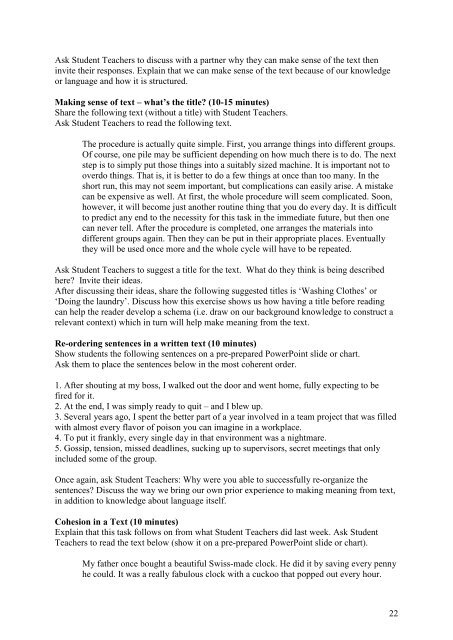course guide - USAID Teacher Education Project
course guide - USAID Teacher Education Project
course guide - USAID Teacher Education Project
Create successful ePaper yourself
Turn your PDF publications into a flip-book with our unique Google optimized e-Paper software.
Ask Student <strong>Teacher</strong>s to discuss with a partner why they can make sense of the text theninvite their responses. Explain that we can make sense of the text because of our knowledgeor language and how it is structured.Making sense of text – what’s the title? (10-15 minutes)Share the following text (without a title) with Student <strong>Teacher</strong>s.Ask Student <strong>Teacher</strong>s to read the following text.The procedure is actually quite simple. First, you arrange things into different groups.Of <strong>course</strong>, one pile may be sufficient depending on how much there is to do. The nextstep is to simply put those things into a suitably sized machine. It is important not tooverdo things. That is, it is better to do a few things at once than too many. In theshort run, this may not seem important, but complications can easily arise. A mistakecan be expensive as well. At first, the whole procedure will seem complicated. Soon,however, it will become just another routine thing that you do every day. It is difficultto predict any end to the necessity for this task in the immediate future, but then onecan never tell. After the procedure is completed, one arranges the materials intodifferent groups again. Then they can be put in their appropriate places. Eventuallythey will be used once more and the whole cycle will have to be repeated.Ask Student <strong>Teacher</strong>s to suggest a title for the text. What do they think is being describedhere? Invite their ideas.After discussing their ideas, share the following suggested titles is ‘Washing Clothes’ or‘Doing the laundry’. Discuss how this exercise shows us how having a title before readingcan help the reader develop a schema (i.e. draw on our background knowledge to construct arelevant context) which in turn will help make meaning from the text.Re-ordering sentences in a written text (10 minutes)Show students the following sentences on a pre-prepared PowerPoint slide or chart.Ask them to place the sentences below in the most coherent order.1. After shouting at my boss, I walked out the door and went home, fully expecting to befired for it.2. At the end, I was simply ready to quit – and I blew up.3. Several years ago, I spent the better part of a year involved in a team project that was filledwith almost every flavor of poison you can imagine in a workplace.4. To put it frankly, every single day in that environment was a nightmare.5. Gossip, tension, missed deadlines, sucking up to supervisors, secret meetings that onlyincluded some of the group.Once again, ask Student <strong>Teacher</strong>s: Why were you able to successfully re-organize thesentences? Discuss the way we bring our own prior experience to making meaning from text,in addition to knowledge about language itself.Cohesion in a Text (10 minutes)Explain that this task follows on from what Student <strong>Teacher</strong>s did last week. Ask Student<strong>Teacher</strong>s to read the text below (show it on a pre-prepared PowerPoint slide or chart).My father once bought a beautiful Swiss-made clock. He did it by saving every pennyhe could. It was a really fabulous clock with a cuckoo that popped out every hour.22
















